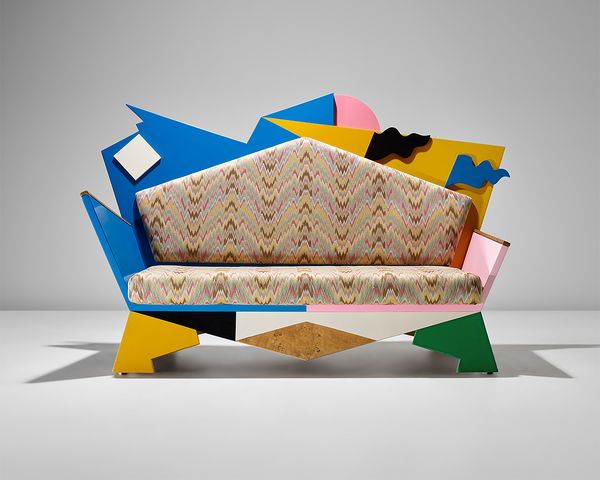Alessandro Mendini, 'Kandissi' sofa, circa 1979. Design London.
Flourishing in Italy from the mid-1960s and into the early years of the 1980s, the avant-garde Radical Design movement imbued conceptual ideas across broad philosophical and artistic ideologies into the making of everyday objects. An influx of new and innovative materials, shapes, and colors inspired postmodern designers to investigate unprecedented forms of expression, transforming conventionally designed objects into works conveying loftier meanings, including commentary on society and the human experience — items made to furnish and navigate the surrounding environments served as a perfect medium for this dimension of creative exploration. In the late 1970s, specifically, the bold and unrestrained aesthetic of these progressive works enthusiastically rekindled an affinity for decoration and ornament which had been eschewed in the preceding decades by the austerity of modernism’s ‘form follows function.’
At the forefront of this movement, Alessandro Mendini contemplated the inherent potential of objects to elevate the human spirit, a concept he expressed in a series titled ‘Objects for Spiritual Use,’ which he exhibited at the 1978 ‘Stanza del Secolo’ at Palazzo Diamanti in Ferrara. Included in this collection was Mendini’s prototype of the present ‘Kandissi’ sofa along with a coordinating mirror also inspired by the artistic works of Wassily Kandinsky, and his famed ‘Proust’ armchair which paid homage to Paul Signac’s paintings, all as examples of ‘redesigns’ which inquired into and conveyed the notion that design can no longer be original — that ‘one can do nothing but redesign'. Mendini explored this idea of artistic intervention for the redesign of objects in two antithetical directions: in the first, he fashioned his own postmodern translations of some of the most celebrated historical modern art and designs by legendary predecessors including Gio Ponti, Marcel Breuer, and Charles Rennie Mackintosh, among others. For the second mode, which the present sofa falls under, Mendini applied his interpretations of renowned artists’ iconic styles such as Kandinsky’s synaesthetic abstract compositions and Signac’s neo-impressionist taches to the silhouettes of everyday furniture pieces.
Original poster of "Bau.Haus one" exhibition, the first Studio Alchimia collection illustrating the present 'Kandissi’ sofa together with other objects, including the 'Ondoso' coffee table, 1979. Graphic project: Alessandro Guerriero. Design: Michele de Lucchi.
Regarding the poetic and spiritual essence of furniture, Kandinsky’s artistic output would have naturally lent itself to Mendini’s series, given the artist’s 1911 treatise ‘Concerning the Spiritual in Art’. In this text, Kandinsky contemplated the effects of color on the human psyche, including the perception and phenomenal effects of blue and yellow, which in turn Mendini has applied as the predominant colors for his own postmodern interpretation. In this way, Mendini has forged a connection between spiritual existence and everyday — or banal — life through the imbuement of Kandinsky’s philosophical considerations into this furniture for a casual, domestic setting, in order to make intellectual contemplation more widely and readily accessible.
These works were some of the earliest statements to emerge from Studio Alchimia, a historically significant collective that incubated collaboration and creative experimentation for societally critical, radical designs. It was here that Mendini created his first pieces to catalyze dialogue on the concept of ‘banal design,’ optimistically advancing the idea of mass intellectual production as an accessible reality instead of a previously assumed utopian dream, including the present ‘Kandissi’ sofa. While this end state of mass adoption was never reached due to the inherent exclusivity of these limited production designs along with the lack of a sales strategy to widely market the series, the existing works symbolize an optimistic perspective for the ideal position of design within society.
Discover More from Design London >
Recommended Reading
The Emergence of the Master: Ettore Sotsass >
Beauty Suspended in Time: Shiro Kuramata >
A Masterpiece of Brazilian Modern Design >
Antiquity Made Modern: Diego Giacometti >

